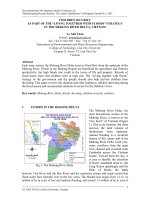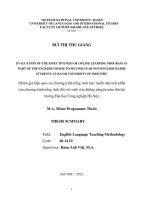a-new-trend-pacific-island-language-teaching-as-part-of-the-belt-and-road-initiative-20190802
Bạn đang xem bản rút gọn của tài liệu. Xem và tải ngay bản đầy đủ của tài liệu tại đây (101.91 KB, 5 trang )
Published on August 2, 2019
(Credit: Long Road Photography CC BY-NC-ND 2.0)
A new trend: Pacific island
language teaching as part of the
Belt and Road Initiative
By Denghua Zhang and Setope So’oa’emalelagi
China’s push for the Belt and Road Initiative (BRI) in the Pacific is receiving
growing attention. All eight Pacific island countries (PICs) that recognise Beijing,
including Cook Islands, Federated States of Micronesia, Fiji, Niue, Papua New
Guinea, Samoa, Tonga and Vanuatu, have signed up to the BRI, an ambitious but
Link:
/>ative-20190802/
Date downloaded: February 19, 2022
Page 1 of 5
Published on August 2, 2019
controversial program designed to link China with countries in Asia, Africa,
Europe, Latin America and even the Pacific.
Much of the spotlight has been on the impact of the BRI overseas. We take a
unique approach by discussing the start of an ambitious PIC language-teaching
program in China, and the program’s role in facilitating the rollout of the BRI in
those PICs with which China has diplomatic relations. While the teaching has the
potential to promote China’s understanding of the region, the sustainability of
teaching languages with relatively few speakers is in question.
Beijing Foreign Studies University (BFSU) has been entrusted with the teaching
of Pacific languages in China. Approved by China’s Ministry of Education in 2017,
BFSU started to advertise new four-year bachelor courses on seven Pacific
languages, including Bislama, Cook Islands Māori, Fijian, Niuean, Samoan, Tok
Pisin and Tongan. These languages cover all of China’s eight diplomatic partner
states in the Pacific. The formal teaching is expected to start soon. Students will
enrol at BFSU’s School of English and International Studies with English as the
first compulsory foreign language and another major foreign language and one of
the aforementioned PIC languages as the second and third elective foreign
languages. It will be part of the bachelor course for the English language
program.
The main driver of this ambitious program appears to be to support China’s
diplomacy and President Xi Jinping’s signature project — the BRI. As BFSU stated
explicitly in the job advertisement for Pacific language teaching positions in
February 2019:
In recent years, to serve the Chinese government’s significant strategies
including ‘go global’, Belt and Road Initiative, promoting language exchange and
learning, building ‘the community of common destiny for mankind’, safeguarding
the diversity of global civilisations, the university willingly accepts the strategic
task of language education, and plans to cover languages of all the countries that
Link:
/>ative-20190802/
Date downloaded: February 19, 2022
Page 2 of 5
Published on August 2, 2019
have diplomatic relations with China by 2020.
To attract talent to teach these foreign languages, the university is offering
lucrative pay and benefits (such as accommodation and research funding), by
China’s standards.
Case study of Samoan teaching
In addition to BFSU, Liaocheng University in China’s Shandong province has
started a Samoan course thanks to the interest from its Research Center for
Pacific Island Countries in enriching Chinese students’ knowledge of Pacific
languages and cultures. It is offered as an elective course. The formal teaching
was started in May 2019 by Setope So‘oa‘emalelagi, a lecturer in Samoan
language with an extensive background in political science and English as a
second language. The opening of the Confucius Institute at the National
University of Samoa in December 2018 triggered growing interest in Samoa from
the BRI and created an opportunity for Liaocheng University to invite Samoan
academics to teach Samoan culture and language from a Samoan perspective.
So far, the course at Liaocheng has had a good start. Chinese students are highly
curious of such a ‘novel’ language and far-flung culture, which to them is exotic.
The program is in its seventh week and the response has been very positive,
despite the students not knowing what to expect at the outset. All students have
been tested on their Samoan language speaking and writing levels and the results
are remarkably encouraging.
The class comprises seven postgraduate students of history and two professors of
history and fine arts, respectively. Students attend one two-hour class per week.
The method of teaching follows a two-pronged approach. First is an introduction
to Samoan culture, history and traditions. Videos of important aspects of Samoan
culture, featuring such things as tattooing, art, dance and customs are shown,
giving students a ‘feel’ for Samoan life. This is followed by phonetics, language
Link:
/>ative-20190802/
Date downloaded: February 19, 2022
Page 3 of 5
Published on August 2, 2019
structure and the learning of everyday expressions. The aim is to engage and
allow students to confidently speak and understand Samoan. An assignment was
given to students asking, ‘Why do you want to learn Samoan language? And how
will learning Samoan language help you find a job?’ The students’ answers were
deep and philosophical, yet the common thread was the need to build bridges
between China and Samoa and gain a deeper sense of international relations.
More interestingly, two postgraduate students of history said, ‘This is a pluralistic
society [China] and the more languages, the more chances’ and ‘understanding a
language means understanding a society’. It seems the students believe that
learning Samoan language opens up new horizons for them and matches newly
acquired language skills with whatever their future careers may hold. They also
appear to find Samoan language relatively easy to speak, write and read,
compared to English.
With the Samoan language program in its infancy, it is difficult to predict how
many students will enrol in the future as either an elective or compulsory course,
because Samoan is largely an unknown language in China.
Implications
China sees the Pacific region as the southern extension of the BRI. It is expected
that the Chinese government will continue to use the BRI to frame China-PIC
cooperation in the near future. The teaching of Pacific languages, if it proceeds
well, could promote China’s understanding of these island countries’ languages,
cultures and other aspects such as politics and economies. It could facilitate the
implementation of the BRI in the region, as Beijing expects.
However, the teaching of Pacific languages at Chinese universities is not without
challenges. Firstly, it is extremely difficult to find Chinese teachers who are
proficient in these languages. In general, China’s academic engagement with the
Pacific has remained limited. To remedy the situation, BFSU has started to send
staff and students to learn some of these languages overseas such as at the
Link:
/>ative-20190802/
Date downloaded: February 19, 2022
Page 4 of 5
Published on August 2, 2019
University of Auckland and the University of Hawai‘i, but it will take time for
China to have a pool of talent in Pacific languages. Another option is to employ
Pacific Island scholars or students studying in China to teach these languages.
For Pacific students, they may not have experience in teaching and their
movement after finishing their study program in China could also inevitably affect
the availability of teachers.
A second challenge is whether the Pacific language courses can attract enough
students, as many students tend to choose to learn more widely spoken languages
such as English, French and Russian. For those who do study Pacific languages,
whether and how they can find related jobs is another obstacle. Chinese
government agencies such as foreign affairs and commerce, and Chinese
companies operating in the Pacific, will not be able to provide a large number of
positions for these graduates. In this sense, the sustainability of China’s ambitious
program of teaching Pacific languages will be tested in the future.
This is an edited version of In Brief 2019/14, originally published by ANU’s
Department of Pacific Affairs as part of their In Brief series.
About the author/s
Denghua Zhang
Dr Denghua Zhang is a Research Fellow at the Coral Bell School of Asia Pacific
Affairs, ANU. His research focuses largely on Chinese foreign aid, foreign policy
and China in the Pacific.
Setope So’oa’emalelagi
Setope So‘oa‘emalelagi is a lecturer in Samoan culture, political science and
history, and a research fellow at the Research Center for Pacific Island Countries
at Liaocheng University, China.
Link:
/>ative-20190802/
Date downloaded: February 19, 2022
Page 5 of 5









